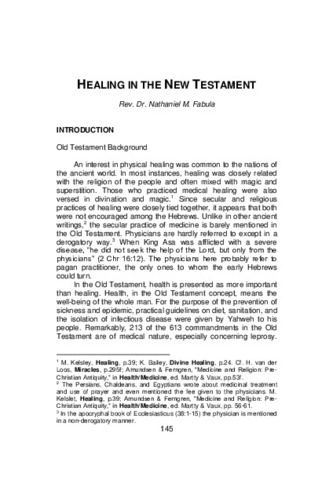Healing in the New Testament
요약
An interest in physical healing was common to the nations of the ancient world. In most instances, healing was closely related with the religion of the people and often mixed with magic and superstition. Those who practiced medical healing were also versed in divination and magic. Since secular and religious practices of healing were closely tied together, it appears that both were not encouraged among the Hebrews. Unlike in other ancient writings, the secular practice of medicine is barely mentioned in the Old Testament. Physicians are hardly referred to except in a derogatory way. When King Asa was afflicted with a severe disease, “he did not seek the help of the Lord, but only from the physicians” (2 Chr 16:12). The physicians here probably refer to pagan practitioner, the only ones to whom the early Hebrews could turn.
In the Old Testament, health is presented as more important than healing. Health, in the Old Testament concept, means the well-being of the whole man. For the purpose of the prevention of sickness and epidemic, practical guidelines on diet, sanitation, and the isolation of infectious disease were given by Yahweh to his people. Remarkably, 213 of the 613 commandments in the Old Testament are of medical nature, especially concerning leprosy.
To protect the public health of the whole community, hygiene and prophylaxis were strictly observed as religious dogma. The priests were responsible for endorsing the injunction pertaining to social hygiene and public health. This role of the priest evidently continued in the New Testament times. Cured lepers were sent to them for examination and observance of the required religious sacrifices for purity reasons.
기술
Journal article
추천 인용
Fabula, N. M. (2007). Healing in the New Testament.유형
Article주제
Collections
- Journal articles [28]
- Journal of Theology [24]


